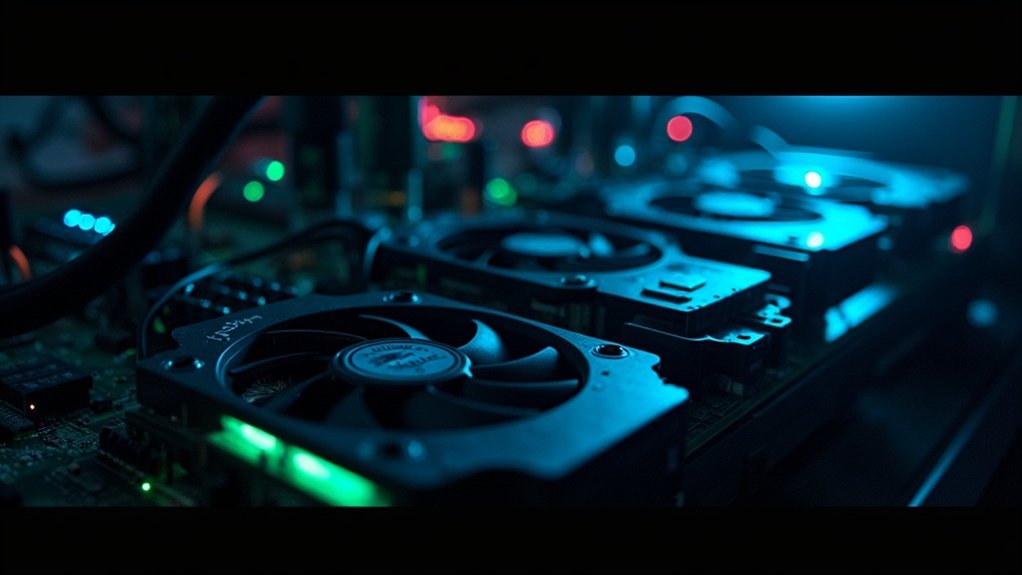Cryptomining powers cryptocurrency networks through competitive puzzle-solving. Miners use powerful computers to crack complex mathematical problems, validating transactions and adding them to the blockchain. Winners receive newly minted coins and transaction fees. It’s not for the faint of heart—specialized hardware, significant electricity, and technical know-how are vital. Mining difficulty adjusts automatically to maintain network integrity. This invisible engine guarantees decentralization works without banks or governments pulling the strings.
While many people think cryptocurrency simply appears out of thin air, cryptomining is the complex process that makes it all possible. It’s the backbone of blockchain networks like Bitcoin, validating transactions and recording them on a public ledger. Miners aren’t just creating new coins. They’re the gatekeepers of the entire system, ensuring everything stays secure and decentralized. No central authority needed. Just computers, electricity, and some serious computational power.
The mining process itself? Not exactly rocket science, but close. Miners compete to solve mathematical puzzles that would make your high school math teacher weep. These puzzles require miners to find a specific hash value through countless trial-and-error attempts. First one to solve it wins. The winner gets to add the next block to the blockchain and—surprise!—receives newly minted cryptocurrency as a reward. Plus transaction fees. Not a bad deal if you can afford the setup. The Proof-of-Work mechanism ensures that all transactions are verified and secured through this competitive process.
Crack the hash, win the cash—if you’ve got computing muscle to flex.
Speaking of setup, you’ll need specialized hardware. Consumer-grade laptops won’t cut it anymore. Serious miners use ASICs or high-powered GPUs that cost a small fortune. Then there’s the software to connect you to the blockchain network. And electricity bills that’ll make your eyes water. Every 2016 blocks, the network automatically adjusts mining difficulty to maintain a consistent 10-minute block creation time.
The whole system relies on cryptography to keep things secure. Mining puzzles are intentionally difficult to solve but easy to verify once completed. It’s like trying to guess a combination lock with billions of possibilities. Frustrating? Absolutely. Effective? You bet.
Miners often join forces in mining pools to increase their chances of success. More computational power means more chances to solve puzzles and earn rewards. These rewards typically halve every few years, keeping things interesting for those in it for the long haul. Many miners are drawn to regions with low-cost electricity as it significantly impacts their profitability margins.
That’s cryptomining in summary. Complex, energy-intensive, and oddly fascinating. The invisible engine powering the cryptocurrency revolution one block at a time.
Frequently Asked Questions
How Much Electricity Does Cryptomining Consume?
Cryptomining consumes massive amounts of electricity. Bitcoin alone uses between 91-160 TWh annually—comparable to entire countries like Finland or Argentina.
The broader crypto market guzzles over 68 TWh yearly. That’s 0.5% of global energy consumption, seven times more than all of Google’s operations.
In the US, crypto mining devours between 0.6-2.3% of total electricity. And despite some renewable adoption, it still pumps out 65 megatons of CO2 annually.
Shocking numbers, honestly.
Can Cryptomining Damage My Computer Hardware?
Yes, cryptomining can absolutely wreck computer hardware. It’s brutal. Running GPUs and CPUs at maximum capacity 24/7 causes significant wear and tear.
The heat generated is relentless—components literally cook over time. Thermal stress damages solder joints and chipsets. Fans work overtime, wearing out faster.
Cryptojacking malware makes it worse, secretly pushing hardware to its limits without the owner knowing. Even mobile devices aren’t safe—batteries degrade, processors burn out. Not pretty.
Which Cryptocurrencies Are Most Profitable to Mine?
Mining profitability constantly shifts.
Bitcoin remains reliable but requires expensive ASICs and cheap electricity. Scrypt coins like Dogecoin and Litecoin offer merged mining efficiency. For GPU miners, Kaspa and Ergo show promise with lower barriers to entry. Monero works with regular CPUs—nice!
Factors affecting profitability? Network difficulty, electricity costs, hardware efficiency, and market prices. The most profitable option changes weekly.
Yesterday’s gold mine is tomorrow’s money pit.
Is Home Mining Still Viable Against Large Mining Operations?
Home mining exists in Bitcoin’s shadow economy. Yes, it’s viable—technically. Small miners are projected to control 54.6% of market share by 2025.
New efficient devices like the Bitaxe Gamma (17 watts) help level the playing field. But profitability? That’s the catch. Electricity costs are brutal. Hardware isn’t cheap ($2,000-$20,000).
Industrial operations have economies of scale regular folks don’t. Solo miners occasionally strike gold, but it’s rare. A tough game, honestly.
What Security Risks Are Associated With Cryptomining?
Cryptomining carries serious security baggage. Malware hijacks victims’ devices for mining without consent, draining resources and damaging hardware. Overheating? Common problem.
Networks face DNS hijacking, API exploits, and botnet attacks that can cripple infrastructure. Mining pools create centralized targets for hackers. Personal data theft happens through fake mining sites.
Even legitimate operations risk unauthorized access when security protocols are weak. Cloud mining? Even worse security implications sometimes.
Electricity spikes often reveal hidden mining operations.









